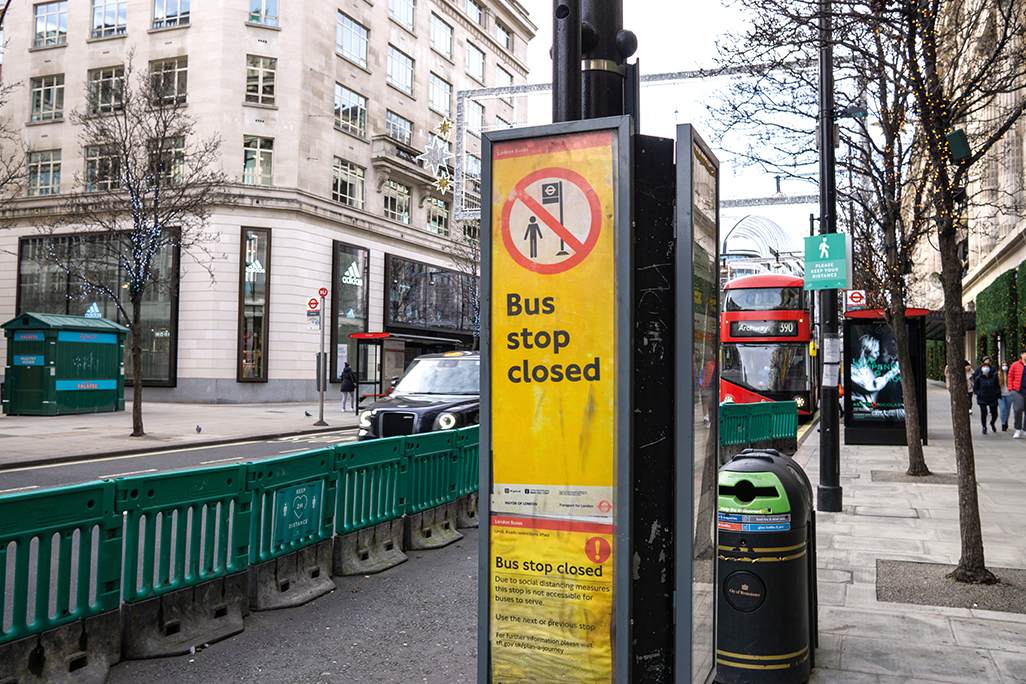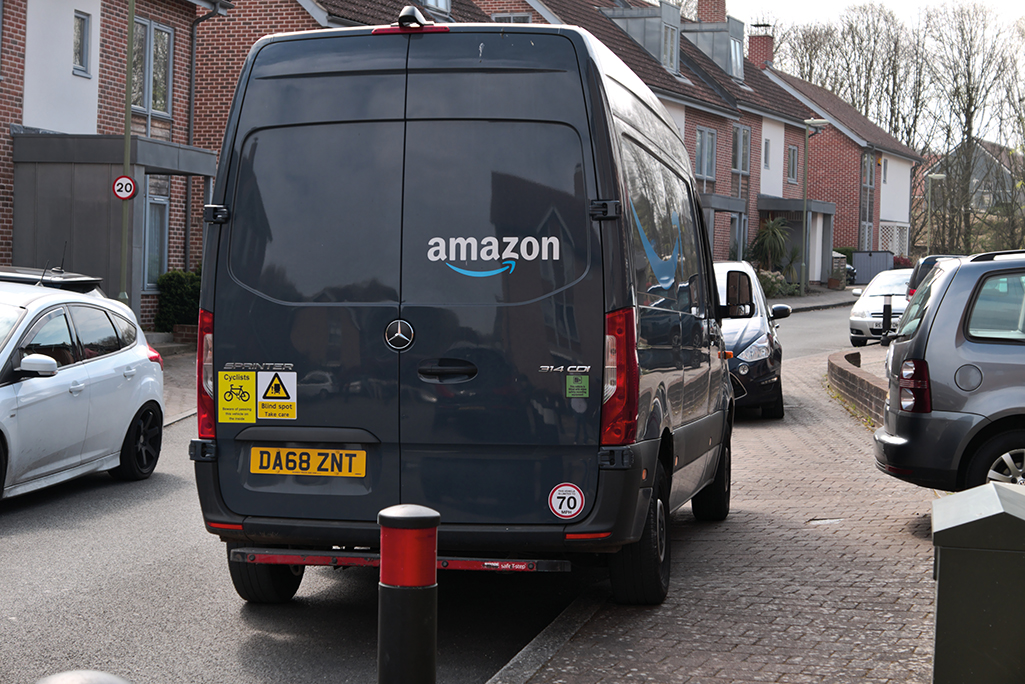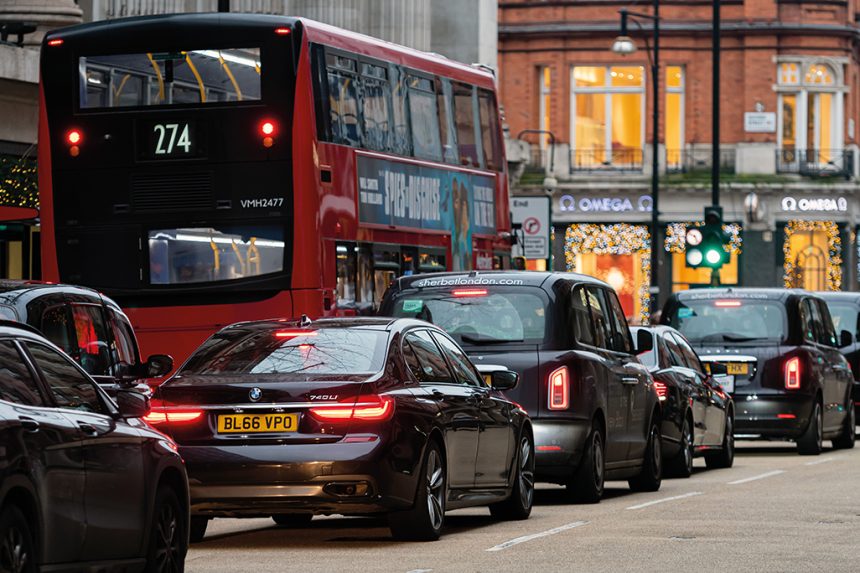Congestion is a costly problem for the coach and bus industry. From wider cars to increasing street works, the reasons seem to be varied
An image of 40 buses queued in traffic on one short piece of road in Manchester raised eyebrows both in the mainstream media and within the industry last month.
Beyond the headlines designed to grab hits, the image typified the very real problem of congestion facing both the coach and bus sectors daily.
Congestion leads to lower coach and bus speeds, which results in higher operating costs, reduced reliability, lower patronage, greater reliance on public funding, added environmental impacts, and reduced economic productivity.
And it’s getting worse. According to Department for Transport (DfT) statistics, the average delay time on urban A roads compared to free-flowing traffic was 8% worse in 2024 than 2023, by when the congestion was back up to prepandemic levels.
I think it is a combination of different things. I don’t think there’s really one answer to it – Richard Tyldesley
Although data for 2024 for minor urban roads is a little harder to come by, anecdotal evidence from operators is that the situation is deteriorating.
According to the latest edition of the Confederation of Passenger Transport’s (CPT) Cost Monitor, overall bus speeds in Great Britain outside London averaged only 12.13mph in June 2024.
Although this was slightly up versus the 11.95mph from the first survey in February 2022, the figures make grim reading. This is particularly the case in London, where bus speeds over the same period fell by 4.1% to 7.5mph.
The cost of congestion for coach and bus
Whippet has undertaken research on the impact of the increase in congestion and found it was potentially almost doubling the cost of running the service.
Director Ed Cameron says: “We use eight buses to run Universal (University of Cambridge service) and, if there was not the volume of traffic during the peak periods and in the day, we could do the same frequency with five buses. Or we could run almost double the number of journeys with the same number.”
But why are the roads apparently becoming more clogged up?
The answer appears to be multifaceted, aside from there simply being more vehicles on the road — up 1.4% in 2024, according to Society of Motor Manufacturers and Traders.
As Ed highlights: “It’s a continual evolution of changing travel habits because of work and leisure activities, changing dynamics around the influence that cyclists and other active travel schemes have, the changing vehicle size, this political resistance to enforcing parking and charging fairly for parking…
“It’s all those factors working together and not a single one that you could say has changed at a certain point.”
Bluestar General Manager Richard Tyldesley agrees, saying: “I think it is a combination of different things. I don’t think there’s really one answer to it…
“The railways have seen a decrease in patronage. Are people making longer journeys in cars as a result?”
Increasing street works
The increase in the volume of street works is one factor which is often cited.
According to the Asphalt Industry Alliance’s Annual Local Authority Road Maintenance (ALARM) survey, the number of “utility company openings” rose by 30% in England to an average of 17,263 per local authority between 2018 and 2024.
“The increase was 5% in London, while the other area covered by the survey, Wales, saw a drop of 2%. Part of the explanation could be a greater number of broadband installations.
The problem of street works is significant enough that it was the subject of a Transport Committee inquiry this year.

Among those attending was CPT Operations Director Keith McNally, who gave anecdotal evidence that the issue was having more of an impact than ever.
Speaking at that Transport Committee session, he added: “Our members say to us that a very high proportion seem to be on an emergency basis. Those are the ones where they get little or no notice.”
Jack Cousens, Head of Roads Policy for the AA, argued at the inquiry that improvements had been seen where highway authorities were allowed to charge companies up to £2,500 per day “lane rental” for works on the busiest roads at the busiest times.
This potentially provides an incentive for different utility companies to collaborate and share the cost.
DfT said in April that only four such authorities — Transport for London, Kent County Council, Surrey County Council, and West Sussex County Council — were then doing so.
Our members say to us that a very high proportion [of street works] seem to be on an emergency basis – Keith McNally
David Boden, Stagecoach East Business Development Director, says lane rental is a “brilliant idea”, adding: “Yes, you have to have water mains put in, electricity pylons put in, fibre put in, but there is zero incentive for water, power, and others to do it in a timely manner.”
Stagecoach East has called on the utility companies to consult more closely with bus operators. As Bluestar General Manager Richard Tyldesley adds: “Utility companies are a law to themselves sometimes.”
Clive Bairsto, Chief Executive at Street Works UK, and Till Sommer, Head of Policy for Internet Services Providers’ Association, agreed at the Transport Committee inquiry that “flexi-permits”, which were currently being trialled, could give roadworks bodies more flexibility, resulting in potentially quicker completion.
Clive also favoured a review of the system of fines for over-runs, in which the poorest performers would be hit hardest.
The active travel factor
While most in the industry would agree that cycle infrastructure has its place in encouraging active travel and thus discouraging private car use, undoubtedly this has been at the cost of bus priority schemes to some degree.
Transport Investment Limited Director David Leeder is among those who have been critical of what he believes is the over-use of cycle lanes, citing it as a factor in the slowing bus speeds in London.
According to TfL, the capital’s strategic cycle network increased by 444% between 2016 and 2023.
“It’s striking that, in London, they’re prepared to put in cycle lanes in the face of public opposition,” he told routeone last year.
“But they’re not prepared to put in bus lanes in general — in fact, they’re prepared to remove them.”
Transport for London Head of Bus Performance Philip Gerhardt responds on that issue: “Whenever there are any decisions with boroughs and also on our network, all road users are considered but buses always have a say.
“There are places where buses may potentially lose time through not having as much road space as they did previously but, elsewhere on the network, they will be getting that back through bus priority, etc.
“When routes are planned, we always consider all road users and cyclists are a key part of that, so we work very closely with other parts of TfL who plan that. So, when any cycle lane is planned, buses are always considered as part of that.”
Impact of home deliveries
The shift towards online shopping has been accompanied by a model of free and easy delivery.
With just one click, consumers can have items arrive the next or even same day without any incentive to group orders together to cut down on the impact on traffic or the environment.
The direct cost of delivery to the consumer is nothing, but the cost in terms of road use is cumulatively huge.
The result: DfT’s data reveal that, while overall vehicle mileage in the UK is still marginally down versus pre-COVID, mileage by vans is up 10.4% over the same period. Delivery vans are undoubtedly a factor in the increase in congestion.

Do we need some form of taxation for deliveries so that the end-user cost better reflects the societal cost?
David Boden says: “It would be useful to explore different models of how to tackle that because of the amount of Amazon and Evri vans that seem to appear… You see those vans abandoned in some very interesting locations.
“I think we need an exploration of how all of us can use road space and contribute to the costs of it. Without making it sound like a war on the motorist, if you’re one person sat in your car, you pay the most, if you’re a delivery person, you pay a bit more, but if you’re a bus driver you pay the least.”
‘Carspreading’
New cars in the UK are becoming 1cm wider every two years, on average in a phenomenon which has become known as “carspreading”.
Research from campaign body Transport and Environment published in January 2024 showed that more than half of new vehicles were wider than the 1.8m which is typical for an on-street parking bay.
Ed says: “Individual vehicles are larger, wider, longer and they take up more space when they’re parked and when they’re in traffic and, on narrow roads like you get in Cambridge, it will mean that, when they’re parked, they get in the way more often.”

David points out that a Stagecoach East service 8 in Bedford had to be rerouted recently due to the issue of parked cars blocking the way.
Oliver Lord, UK Head of Clean Cities, says: “The bigger SUVs are squeezing out cycle lanes, which is quite striking, and undoubtedly applies to buses too.”
Behaviour change
The change in passenger travel habits could also be having a negative impact. Speaking of the post-pandemic phenomenon, which was also noted by Richard, Ed says: “As a bus operator, it’s slightly more challenging because you need that resource all day, whereas previously it was just in the peak and it relaxed off-peak.”
Looking for answers
The £20 million Intelligent Traffic Management Fund (ITMF), which opened last year but was controversially cancelled after around six months by the current government, could have been one solution.
Under that scheme, local authorities could apply for funding to use emerging technologies such as machine learning to optimise traffic control.
Travel and Transport Consultant Dr Phil Evans is a great believer in using the latest technology to help solve the problem. He supports some form of national dynamic road pricing scheme.
He suggests: “For example, at rush hour, driving into Oxford is an absolute nightmare and a no, no. So the price of doing so would be extortionate, while at other parts of the day that price would change. What that will do is change people’s behaviour. I think this sort of carrot and stick type approach is where we need to be going.”
For David, the solution is three-fold: “Sorting out the New Works and Street Works Act; two, having a sensible approach to sharing road space; and, three, just sorting out bottlenecks, and one big thing that would help with that is traffic signal priority.”

























